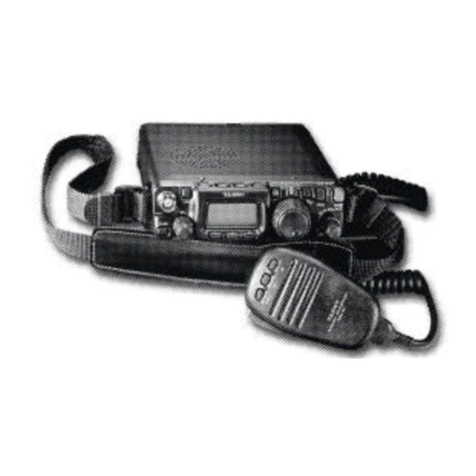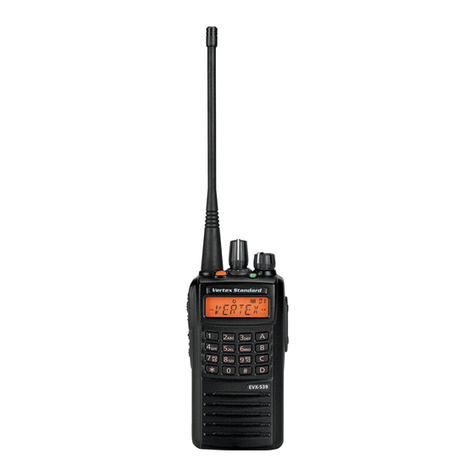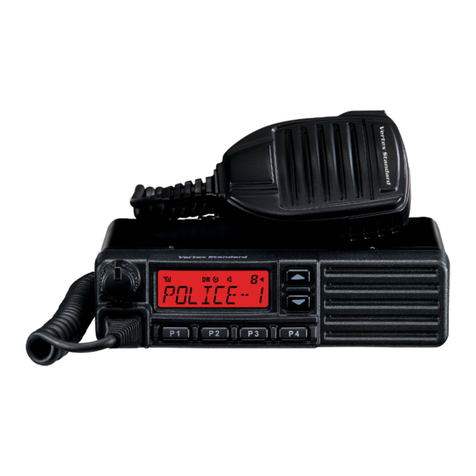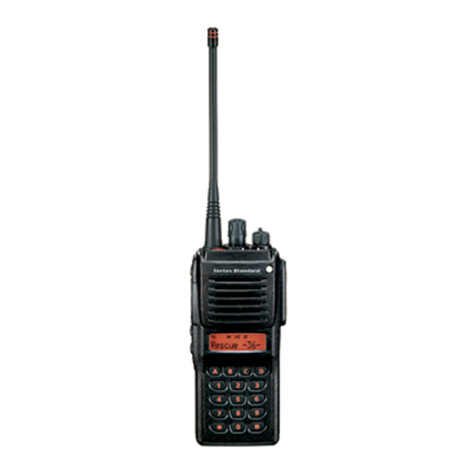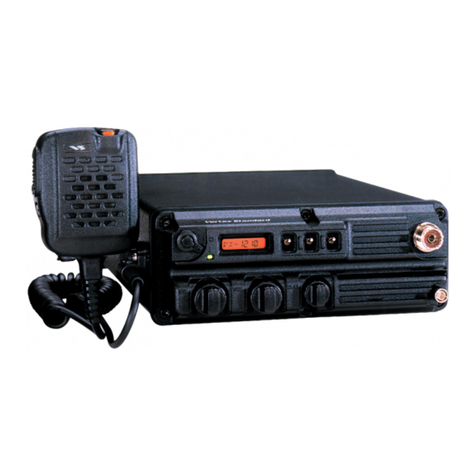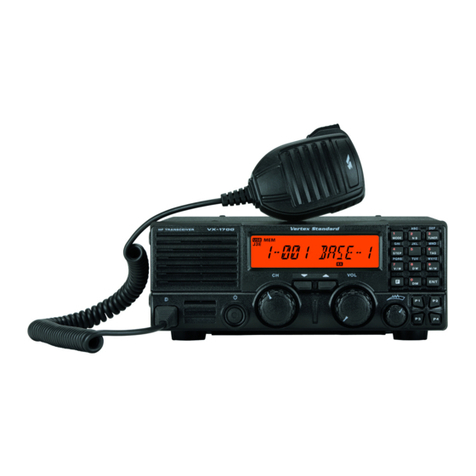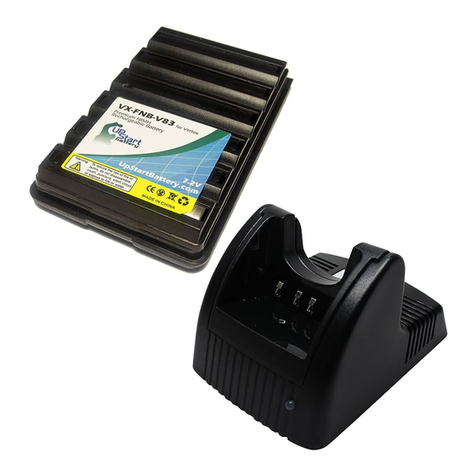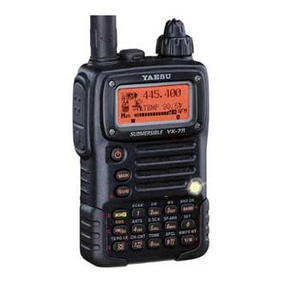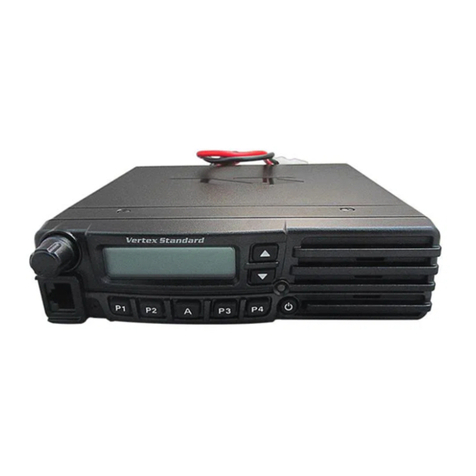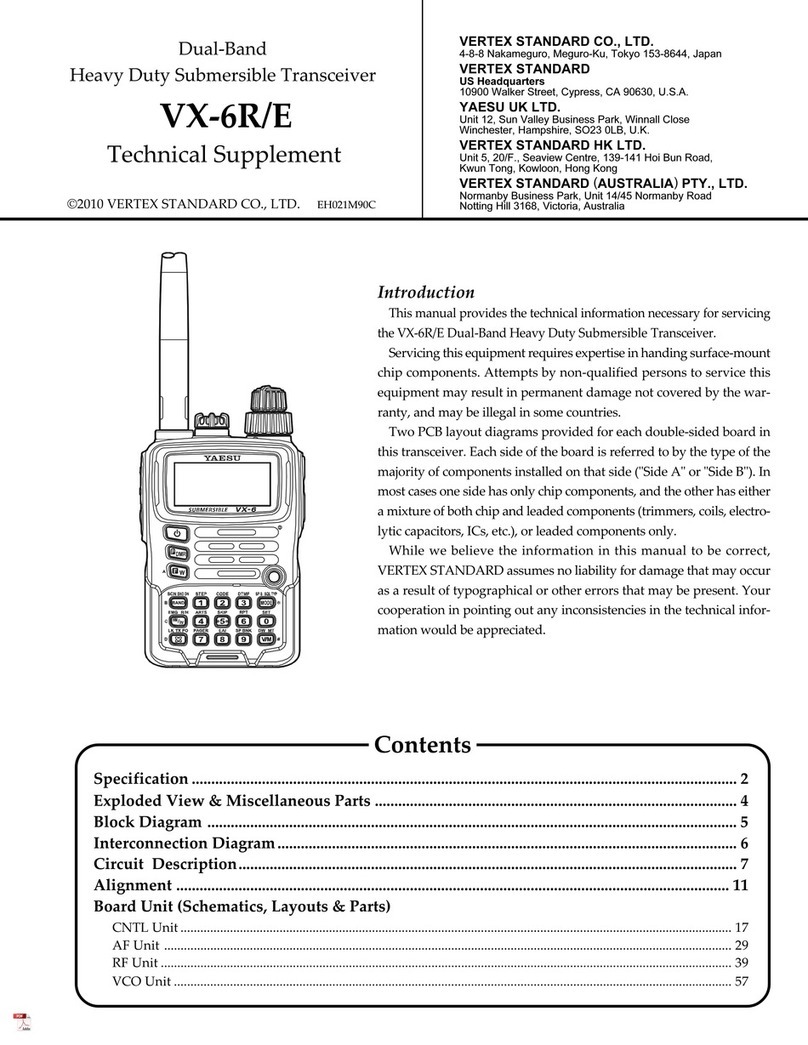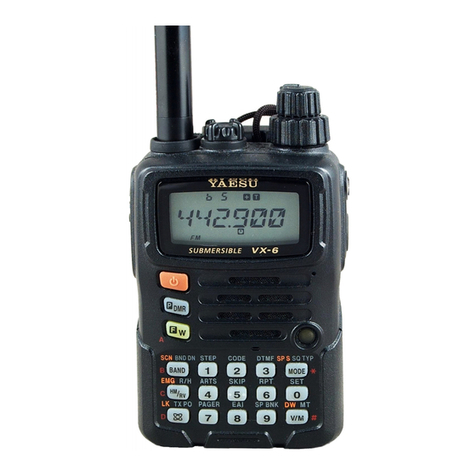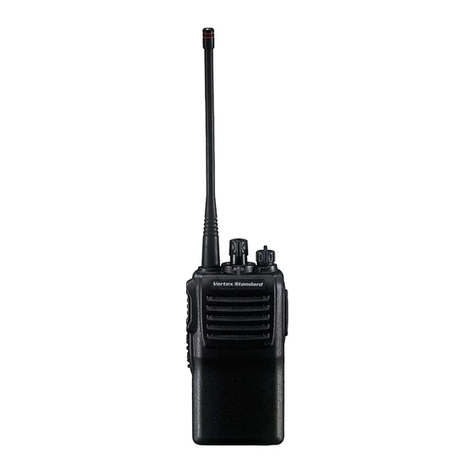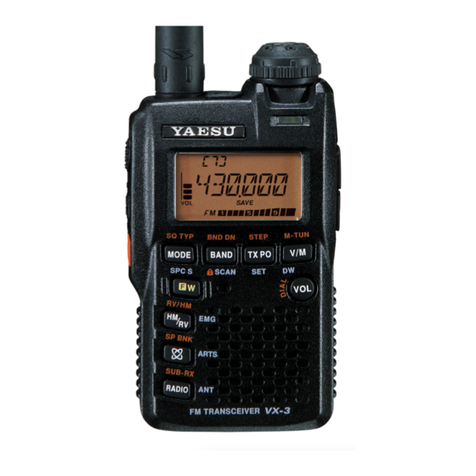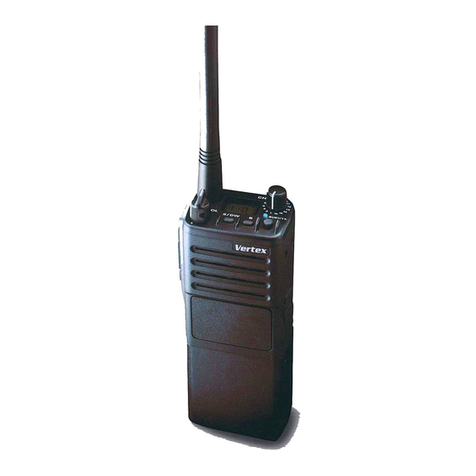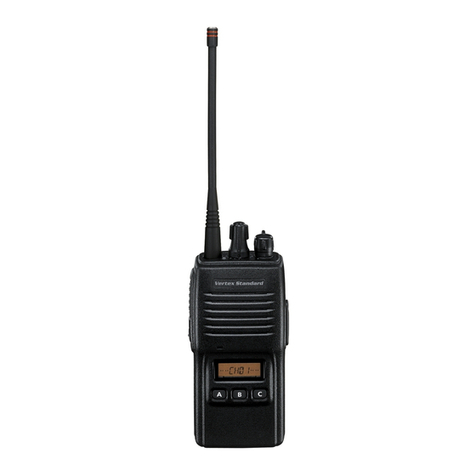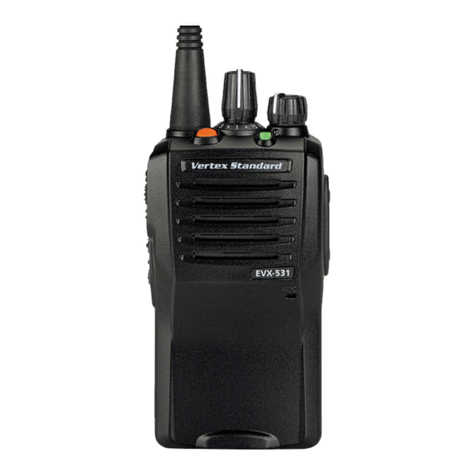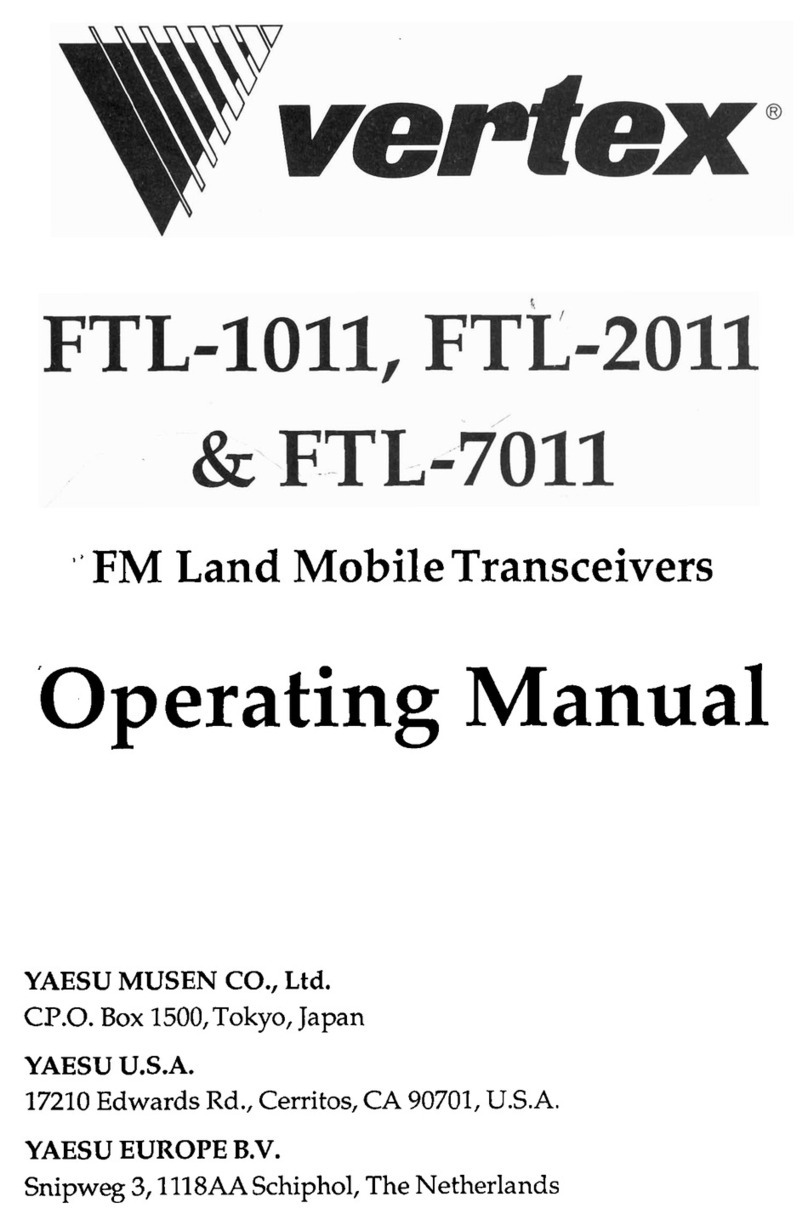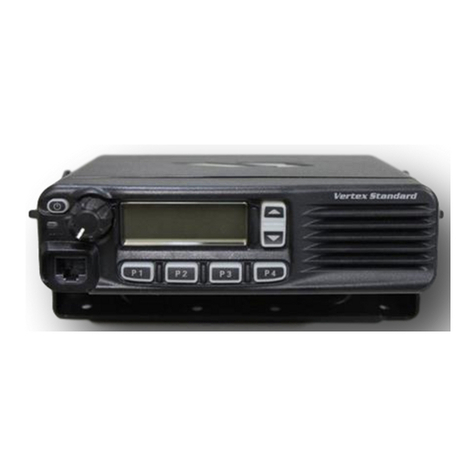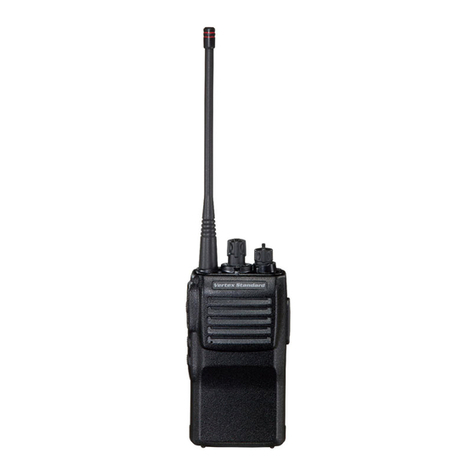
7
Circuit Description
The VX-5R internal assembly consists of the RF Unit,
Control (CNTL) Unit, and the AF Unit. The RF Unit con-
tains the receiver front end, PLL IC, power and switching
circuits, and the VCO Unit for transmit and receive local
signal oscillation. The CNTL Unit contains the CPU and
audio ICs, as well as the power circuitry for the LCD. The
AF Unit contains the IF, plus audio ICs.
Receiver Signal Flow
The VX-5R includes five receiver front ends, each opti-
mized for a particular frequency range and mode combi-
nation.
(1) Triplexer
Signals between 0.5 and 540 MHz received at the anten-
na terminal pass through an input low-pass filter com-
posed of L3059, L3060, C3176, and C3175.
Received 430 MHz signals then pass through a low-pass
filter, CF3002 (GLP9-450M), to the UHF T/R switch cir-
cuit composed of diode switch D3034 (RLS135), D3038
(1SV307), and D3041 (1SV271).
Received 145 MHz signals, after passing through the first
low-pass filter, are passed through low-pass filter CF3003
(GLP8-148M) to the VHF T/R switch circuit, composed of
diode switch D3035 (RLS135), D3039 (1SV307), D3043
(1SV271), and Q3055 (DTC143ZE).
On the 6-meter band, the 50 MHz signals, after passing
through the first low-pass filter, are passed through low-
pass filter L3055, C3164, C3169, and C3163 to the 50 MHz
T/R switch circuit composed of diode switches D3036
(RLS135) and D3040 (1SV307).
(2) 145 MHz Band Reception
Received signals between 140 and 150 MHz pass
through the Triplexer circuit, VHF T/R switch circuit, pro-
tector diode D3003 (1SS362), and 1st VHF band switch
D3010 (DAN235E) before additional filtering by a band-
pass filter consisting of C3023, L3010, and C3032. The sig-
nals are then applied to RF amplifier Q3013 (2SC5374).
The amplified RF signal is band-pass filtered by CF3001
(LFB30N11B0146B010PT) and applied through the 2nd
VHF band switch circuit D3025 (DAN235E) to the first
mixer, Q3020 (2SC5374).
Meanwhile, VHF output from pin 5 of the VCO Unit is
amplified by Q3023 (2SC5374) and applied through di-
ode T/R switch D3030 (DAN222) to mixer Q3020 as the
first local signal.
The 47.25 MHz intermediate frequency product of the
mixer is delivered to the AF Unit.
(3) 435 MHz Band and 222 ~ 540 MHz Reception
Received signals between 430 and 450 MHz pass
through the Triplexer circuit, UHF T/R switch circuit, pro-
tector diode D3002 (1SS362), and a variable band-pass
filter composed of L3006, D3008 (HVC358B), and C3017
before application to RF amplifier Q3007 (2SC5374).
The amplified RF signal is then filtered by a two-stage
variable band-pass filter composed of L3014, D3012
(HVC358B), C3040, C3044, D3015 (HVC358B), C3054, and
L3020, then further amplified by Q3016 (2SC5374). The
output of Q3016 is applied to a variable band pass filter
composed of L3029, D3024 (HVC358B), and C3079 so that
only signals within the desired frequency range are deliv-
ered to the first mixer, Q3019 (2SC5374).
Meanwhile, UHF output from pin 2 of the VCO Unit is
amplified by Q3022 (2SC5374) and applied through di-
ode T/R switch D3032 (HN2D01FU) to mixer Q3019 as the
“430 Local” first local signal. The 47.25 MHz intermedi-
ate frequency product of the mixer is delivered to the AF
Unit.
The “TUNE” voltage from the CPU on the CNTL Unit
is amplified by DC amplifier Q3056 (TC75S51F) and ap-
plied to varactors D3008, D3012, D3015, and D3024 in the
variable frequency band-pass filters. By changing the elec-
trostatic capacitance of the varactors, optimum filter char-
acteristics are provided for each specific operating fre-
quency.
(4) 50 MHz Band and 47 ~ 76 MHz Reception
Received signals between 50 and 54 MHz pass through
the Triplexer circuit, T/R switch circuit, protector diode
D3004 (1SS362), and a variable band-pass filter composed
of L3007, C3015, C3021, L3009, and C3025 before applica-
tion to RF amplifier Q3009 (2SC4400).
The amplified RF signal is then filtered by a two-stage
variable band-pass filter composed of L3017, D3013
(HVC300A), C3047, C3048, D3016 (HVC300A), C3055, and
L3021, then further amplified by Q3009, so that only sig-
nals within the desired frequency range are delivered to
the first mixer, Q3017 (2SC4400).
Meanwhile, 50 MHz output from pin 7 of the VCO Unit
is amplified by Q3024 (2SC5374) and applied through
diode T/R switch D3046 (DAN222) to mixer Q3017 as the
“50 Local” first local signal. The 47.25 MHz intermediate
frequency product of the mixer is delivered to the AF Unit.
The “TUNE” voltage from the CPU on the CNTL Unit
is amplified by DC amplifier Q3056 (TC75S51F) and ap-
plied to varactors D3013 and D3016 in the variable fre-
